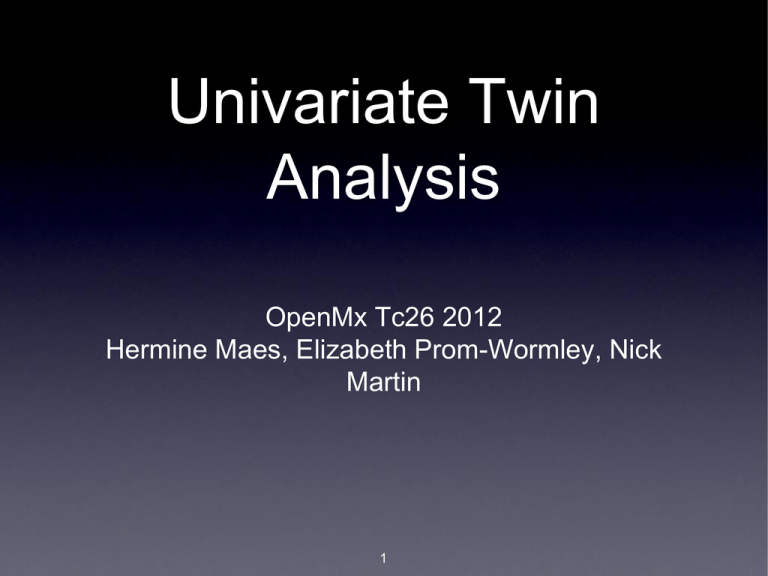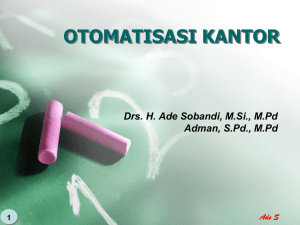
Univariate Twin
Analysis
OpenMx Tc26 2012
Hermine Maes, Elizabeth Prom-Wormley, Nick
Martin
1
Overall Questions to be
Answered
• Does a trait of interest cluster among related
individuals?
• Can clustering be explained by genetic or
environmental effects?
• What is the best way to explain the degree to
which genetic and environmental effects affect
a trait?
2
Family & Twin Study
Designs
• Family Studies
• Classical Twin Studies
• Adoption Studies
• Extended Twin Studies
3
569 total MZ pairs
351 total DZ pairs
The Data
• Australian Twin Register
• 18-30 years old, males and females
• Work
from this session will focus on Body
Mass Index (weight/height ) in females only
2
• Sample size
• MZF = 534 complete pairs (zyg = 1)
• DZF = 328 complete pairs (zyg = 3)
4
A Quick Look at the Data
5
Classical Twin Studies
Basic Background
• The Classical Twin Study (CTS) uses MZ
and DZ twins reared together
• MZ twins share 100% of their genes
• DZ twins share on average 50% of their
genes
• Expectation- Genetic factors are assumed
to contribute to a phenotype when MZ twins
6
are more similar than
DZ twins
Classical Twin Study
Assumptions
• MZ twins are genetically identical
• Equal Environments of MZ and DZ
pairs
7
Basic Data Assumptions
• MZ
and DZ twins are sampled from the same
population, therefore we expect :• Equal means/variances in Twin 1 and Twin 2
• Equal means/variances in MZ and DZ twins
• Further
assumptions would need to be tested
if we introduce male twins and opposite sex
twin pairs
8
“Old Fashioned” Data
Checking
MZ
T1
DZ
T2
T1
T2
mean
21.35 21.34
21.45 21.46
variance
0.73
0.77
covariance(T1-T2)
0.79
0.59
0.82
0.25
Nice, but how can we actually be sure that these
means and variances are truly the same?
9
Univariate Analysis
A
Roadmap
1- Use the data to test basic assumptions (equal
means & variances for twin 1/twin 2 and MZ/DZ
pairs)
Saturated Model
2- Estimate contributions of genetic and
environmental effects on the total variance of a
phenotype
ACE or ADE Models
3- Test ACE (ADE) submodels to identify and
report significant genetic and environmental
10
contributions
Saturated Twin Model
11
Saturated Code
Deconstructed
mMZ1 mMZ2
mean MZ = 1 x 2 matrix
mDZ1 mDZ2
12
mean DZ = 1 x 2 matrix
Saturated Code Deconstructed
T1
T2
T1 vMZ1
cMZ21
T2 cMZ21
vMZ2
covMZ = 2 x 2 matrix
T1
T2
vDZ1
cDZ21
T2 cDZ21
vDZ2
T1
covDZ = 2 x 2 matrix
13
Time to Play...
with OpenMx
Please Open the File
twinSatCon.R
14
Estimated Values
mean
cov
MZ
T1
T2
T1
T2
Saturated Model
DZ
T1
T2
T1
10 Total Parameters
mMZ1, mMZ2,
Estimated
vMZ1,vMZ2,cMZ21
mDZ1, mDZ2,
vDZ1,vDZ2,cDZ21
Standardize
covariance matrices for
twin pair correlations (covMZ &
covDZ)
T2
Estimated Values
mean
cov
MZ
T1
T2
T1
T2
Saturated Model
21.34 21.35 DZ
0.73
T1
0.59 0.79
T2
T1
21.45 21.46
0.77
0.24 0.82
10 Total Parameters
mMZ1, mMZ2,
Estimated
vMZ1,vMZ2,cMZ21
mDZ1, mDZ2,
vDZ1,vDZ2,cDZ21
Standardize
covariance matrices for
twin pair correlations (covMZ &
covDZ)
16
T2
Fitting Nested Models
• Saturated Model
•
•
• likelihood of data without any constraints
• fitting as many means and (co)variances as possible
Equality of means & variances by twin
order
• test if mean of twin 1 = mean of twin 2
• test if variance of twin 1 = variance of twin 2
Equality of means & variances by
zygosity
• test if mean of MZ = mean of DZ
• test if variance of MZ = variance of DZ
17
Estimated Values
T1
T2
T1
T2
Equate Means & Variances across Twin Order
mean
MZ
DZ
cov
T1
T1
T2
T2
Equate Means Variances across Twin Order & Zygosity
mean
cov
MZ
T1
T2
DZ
T1
T2
Estimates
T1
T2
T1
T2
Equate Means & Variances across Twin Order
mean
MZ
21.35 21.35
DZ
21.45 21.45
cov
T1
0.76
T1
0.79
T2
0.59
0.76
T2
0.24
0.79
Equate Means Variances across Twin Order & Zygosity
mean
cov
MZ
T1
T2
21.39
0.78
0.61
21.39
0.78
19
DZ
T1
T2
21.39
0.78
0.23
21.39
0.78
Stats
Model
Saturated
mT1=mT2
mT1=mT2 &
varT1=VarT2
Zyg
MZ=DZ
ep
-2ll
df
AIC
diff - diff
2ll df
p
10 4055.93 1767 521.93
8
4056 1769
518
0.07
2 0.97
6 4058.94 1771 516.94 3.01
4 0.56
4 4063.45 1773 517.45 7.52
6 0.28
No significant differences between saturated model
and models where means/variances/covariances
are equal by zygosity and between twins
20
Questions?
This is all great, but we still don’t
understand the genetic and
environmental contributions to BMI
21
Patterns of Twin Correlation
rMZ = 2rDZ
Additive
DZ twins on
average
share 50% of
additive
effects
rMZ = rDZ
Shared
Environmen
t
rMZ > 2rDZ
Additive &
Dominance
DZ twins on
average
share 25%
of
dominance
effects
22
???
Additive &
“Shared
Environment
”
A = 2(rMZ-rDZ)
C = 2rDZ - rMZ
E = 1- rMZ
BMI Twin Correlations
A = 2(rMZ-rDZ)
C = 2rDZ - rMZ
E = 1- rMZ
A = 0.96
C = -0.20
E = 0.22
0.78
ADE or ACE?
0.30
23
Univariate Analysis
A Roadmap
1- Use the data to test basic assumptions inherent
to standard ACE (ADE) models
Saturated Model
2- Estimate contributions of genetic and
environmental effects on the total variance of a
phenotype
ADE or ACE Models
3- Test ADE (ACE) submodels to identify and
report significant genetic and environmental
contributions
24
ADE Model
A Few Considerations
• Dominance refers to non-additive genetic
effects resulting from interactions between
alleles at the same locus
• ADE models also include effects of interactions
between different loci (epistasis)
• In addition to sharing on average 50% of their
DNA, DZ twins also share about 25% of effects
due to dominance
25
ADE Model Deconstructed
Path Coefficients
a
1 x 1 matrix
d
1 x 1 matrix
e
26
1 x 1 matrix
ADE Model Deconstructed
Variance Components
a
*
aT
1 x 1 matrix
d
*
dT
1 x 1 matrix
e
27
*
eT
1 x 1 matrix
ADE Model Deconstructed
Means & Covariances
expMea
n
expMea
n
expMean= 1 x 2 matrix
T1
T1
T2
28
T2
A+D+E
A+D+E
covMZ & covDZ= 2 x 2 matrix
ADE Model Deconstructed
Means & Covariances
T1
T1
T2
A+D+E
A
T1
T1
T2
29
T2
A+D+E
T2
A+D+E
0.5A
A+D+E
ADE Model Deconstructed
Means & Covariances
T1
T1
T2
A+D+E
A+D
A+D
A+D+E
T1
T1
T2
30
T2
T2
A+D+E
0.5A+0.25D
0.5A+0.25D
A+D+E
ADE Model Deconstructed
4 Parameters
Estimated
ExpMean
Variance due to A
Variance due to D
Variance 31due to E
Univariate Analysis
A Roadmap
1- Use the data to test basic assumptions inherent
to standard ACE (ADE) models
Saturated Model
2- Estimate contributions of genetic and
environmental effects on the total variance of a
phenotype
ADE or ACE Models
3- Test ADE (ACE) submodels to identify and
report significant genetic and environmental
contributions
32
Time to Play...
with OpenMx
Please Open the File
twinACECon.R
33
Testing Specific Questions
• ‘Full’ ADE Model
• Comparison against Saturated
• Nested Models
• AE Model
• test significance of D
• E Model vs AE Model
• test significance of A
• E Model vs ADE Model
• test combined significance of A & D
34
AE Model Deconstructed
New Object
Containing
AE Model
AeModel
Object containing
Full Model
<- mxModel( AdeFit, name="AE" )
The d
path will not be
AeModel,estimated
AeModel <- omxSetParameters(
labels="c11", free=FALSE, values=0)
AeFit
<- mxRun(AeModel)
35
Fixing the value of
the c path to zero
Goodness of Fit Stats
ep
-2ll
df
AIC
diff - diff
2ll df
no!
no!
no!
no!
no! no! no!
p
Saturated
ADE
AE
DE
E
36
Goodness-of-Fit
Statistics
ep
Saturated
-2ll
df
AIC
10 4055.93 1767 521.93
diff 2ll
diff
df
p
-
-
-
ADE
4
4063.45 1773 517.45 7.52
6
0.28
AE
3
4067.66 1774 519.66 4.21
1
0.06
E
2
4591.79 1775 1041.79 528.3
2
0.00
What about the magnitudes of
genetic and environmental
contributions to BMI?
38
Univariate Analysis
A Roadmap
1- Use the data to test basic assumptions inherent
to standard ACE (ADE) models
Saturated Model
2- Estimate contributions of genetic and
environmental effects on the total variance of a
phenotype
ADE or ACE Models
3- Test ADE (ACE) submodels to identify and
report significant genetic and environmental
contributions
39
Estimated Values
a
d
e
c
ADE
-
AE
-
E
40
a2
d2
e2
c2
Estimated Values
a
d
e
ADE 0.57 0.54 0.41
c
a2
d2
e2
-
0.41 0.37 0.22
AE
0.78
-
0.42
-
0.78
-
0.22
E
-
-
0.88
-
-
-
1.00
Okay, so we have a
sense of which model
best explains the
data...or do we?
42
BMI Twin Correlations
A = 2(rMZ-rDZ)
C = 2rDZ - rMZ
E = 1- rMZ
ADE or ACE?
0.78
0.30
43
Giving the ACE Model a
Try
(if there is time)
44
Goodness-of-Fit
Statistics
Model
ep
-2ll
df
Saturated
ADE
ACE
45
AIC
diff - diff
2ll
df
p
Goodness-of-Fit
Statistics
Model
ep
-2ll
df
AIC
Saturated 10 4055.93 1767 521.93
diff - diff
2ll
df
-
p
-
-
ADE
4
4063.45 1773 517.45 7.52
6
0.28
ACE
4
4067.66 1773 521.66 11.73 6
0.07
46
Estimated Values
a
d
e
c
ADE
AE
ACE
AE
E
47
a2
d2
e2
c2
Estimated Values
a
d
e
ADE 0.57 0.54 0.41
c
a2
d2
e2
c2
-
0.41 0.37 0.22
-
0.42
-
0.78
0.22
-
ACE 0.78 0.00 0.42
-
0.78 0.00 0.22
-
AE 0.78
-
-
AE
-
-
0.56 0.68
-
-
0.41 0.59
E
-
-
0.88
-
-
1.00
-
-
Conclusions
• BMI in young OZ females (age 18-30)
• additive genetic factors: highly
significant
• dominance: borderline significant
• specific environmental factors:
significant
• shared environmental factors: not
49
Potential
Complications
• Assortative Mating
• Gene-Environment Correlation
• Gene-Environment Interaction
• Sex Limitation
• Gene-Age Interaction
50
Thank You!
51








